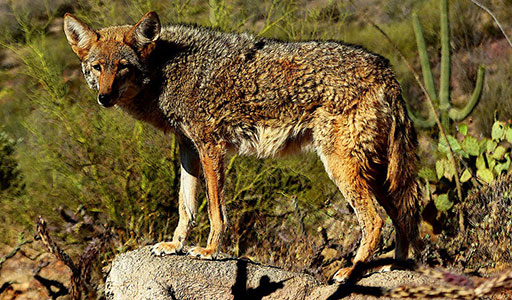Coyote Control
Do you need to get rid of coyotes? We can help!

Coyote Removal Strategies
Coyotes are dog-like mammals with sharp teeth and thick grey fur. Coyotes weigh around 20-40 lbs and are typically nocturnal. During the warm summer months, coyotes may be more active during daylight hours. A coyote will enter into urban areas and near homes in search of food. When coyotes enter into these urban areas, they pose a risk to small pets such as cats or dogs. Coyotes are likely to prey on house pets if they come in close proximity to them on your property.
To avoid a dangerous situation for both you and the coyote, avoid trying to capture one of these animals on your own. One of Trutech’s specialists has the skills to perform effective coyote control services to ensure that these animals stay off of your property and cause no harm to your pets or small children. Don’t wait- call the wildlife management experts at Trutech for all of your coyote removal and coyote control needs.
Hear what a Coyote sounds like
Coyote Problem

Signs a Coyote is on Your Property
Have you encountered coyote tracks on your property? Whether you have small pets or not, it is important to call the experts at Trutech is you think you have a problem with coyotes. Our licensed specialists have extensive knowledge of wildlife management and are able to efficiently and humanely remove any coyotes from your property, whether dead or alive. Trutech’s coyote removal services are guaranteed to give you, and your pets, a peace of mind when it comes to feeling safe on your property.

Dangers of Coyote Infestation
Coyotes are known carriers of dangerous diseases like rabies, and their presence in urban areas can cause problems when they encounter vehicles on roadways. They are also capable of inflicting severe wounds. Human fatalities aren’t uncommon when multiple coyotes from a pack decide to attack. Additionally, coyotes hunt livestock, game animals, and poultry meant for human consumption. They may even attack pets like cats or small dogs.
Humane Coyote Removal & Control Strategies

Entry into property
Reliable food sources are what mainly attract coyotes to residential areas. As they are timid creatures, coyotes will likely avoid entering houses, but they do enjoy foraging in yards. Unsecured garbage, pet food left outside, and the presence of livestock, like backyard chicken coops or animal pens, all tempt coyotes as they are easy meals.

Trapping & Removal
Most areas of the country allow nuisance coyotes to be removed with a permit from state wildlife officials, and some states allow hunting without restriction. Due to their widespread populations across the country, though, hunting is generally not an effective long-term control method. New packs of coyotes move into unoccupied areas after another has been removed. Therefore, residents are better off contacting local wildlife control experts who have the knowledge, experience, and tools necessary to manage nuisance coyote problems.

Prevention & Exclusion
Keeping coyotes away from homes and yards usually involves a two-fold strategy. First, residents should remove food sources that draw the animal to the area. Secure garbage in tightly sealed bins, clean up leftovers after picnics or cookouts, bring outdoor pet food inside at night, and secure any livestock or poultry in coops or barns. Secondly, fences can be useful to keep coyotes out, but only if they are partially buried under the ground to thwart digging.
Frequently Asked Questions
Though it is more common to hear of coyote attacks on dogs and other pets or livestock, the pests may also lash out at children or the elderly. A coyote becomes emboldened when it has established new feeding grounds, starting by feasting from uncovered trash bins. Once the animal begins to act aggressively, it may move on to larger prey. Coyotes seldom seek out people, but their predatory instincts and willingness to defend themselves can lead to painful conflicts.
Coyotes in the backyard are becoming a much more familiar sight as the pests have adapted to urban and suburban settings. The pests are curious by nature and prey on small mammals, such as rabbits, rats, and mice, but also consume roadkill and trash. As many of these food sources are available on private properties, coyotes frequently hang out in yards looking for food.
In western cities, where the pests are most prevalent, coyotes have adapted to living around humans. They regularly hang around suburban neighborhoods and associate people with food and protection. As such, the pests are drawn to private properties.
Though most of coyotes’ favorite foods are found outdoors, like wild rabbits, carrion, deer, and poultry, some dietary staples are more commonly available inside homes, such as garbage, fruits, pet food, and even rodents. For this reason, though it’s rare, individuals may occasionally encounter a coyote in the house that’s wandered inside though an open door or pet flap.

